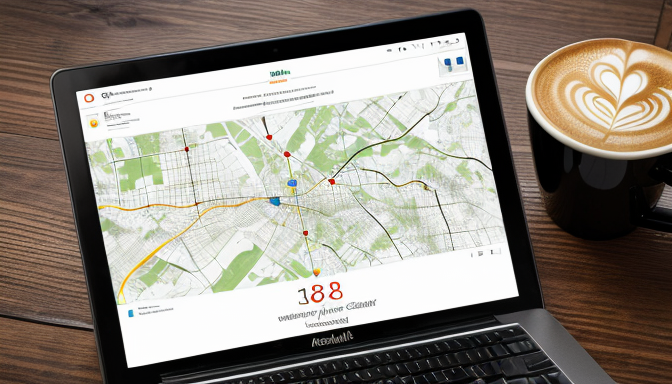
In today’s digital world, it’s crucial for businesses to understand how their competitors are presenting themselves online. One of the most effective ways to do this is by studying competitor maps listings. This involves taking a close look at how others in your industry are displayed on mapping services like Google Maps. Why is this important? Because these listings can make or break a business’s visibility and customer engagement.
When you , you’re not just gathering data; you’re uncovering valuable insights. For instance, you can see how competitors are using keywords, what images they choose, and how they engage with customer reviews. This information can be a goldmine for your own marketing strategies. Think of it as looking over your neighbor’s fence to see what they’re planting in their garden. You might discover new flowers to grow in your own yard!
Moreover, analyzing these listings helps you spot trends in your market. Are competitors offering special promotions? Are they highlighting unique services? By keeping an eye on these details, you can adjust your own listings to stay competitive. It’s all about being proactive. If you notice that a competitor is getting a lot of traction from a certain type of post or promotion, you might want to consider how you can incorporate similar tactics into your own strategy.
But it’s not just about copying what others do. It’s about learning from their successes and mistakes. For example, if a competitor has a high rating but few reviews, it might indicate they’re not engaging enough with their customers. You can take this as a cue to ramp up your own customer interaction. On the flip side, if you see a competitor with a low rating, you can analyze what went wrong and avoid those pitfalls.
In conclusion, when you , you’re not just looking at maps; you’re looking at strategies, customer engagement, and market positioning. This analysis can help you refine your own approach, improve visibility, and ultimately drive more traffic to your business. So, roll up your sleeves and dive into the data. What you find might just surprise you!

Analyze Competitor Maps Listings Details
When it comes to improving your business visibility, analyzing competitor maps listings is crucial. Think of it as peeking into your neighbor’s yard to see what they’re planting. You want to know what works for them and what doesn’t. By diving deep into the details of their maps listings, you can uncover valuable insights that can help you refine your own strategies.
First off, take a close look at the information they provide. What details are included? Are they using high-quality images? Is their contact information easy to find? These elements can make a huge difference in attracting customers. For example, if a competitor has a vibrant, eye-catching photo of their storefront, it might draw in more foot traffic than a bland image. This is why you should pay attention to the visual aspects of their listings.
Next, consider the keywords they use. Are they targeting specific phrases that resonate with your audience? By identifying these keywords, you can enhance your own maps listings. It’s like finding the secret sauce that makes their listings pop. Use tools like Google Keyword Planner to see what terms are driving traffic to their listings.
Additionally, look at their customer reviews. What are people saying? Positive reviews can boost credibility, while negative ones can highlight areas where you can excel. If you notice a competitor consistently receives complaints about long wait times, that’s your opportunity to stand out by offering faster service. Remember, it’s not just about what they do well; it’s also about where they fall short.
Lastly, keep an eye on any updates they make. The digital landscape is always changing, and so are the tactics of your competitors. Set up alerts or regularly check their listings to see how they adapt. This not only keeps you informed but also allows you to stay one step ahead. In the world of business, being proactive can make all the difference.
In summary, analyzing competitor maps listings details is not just about copying what others do. It’s about understanding their strengths and weaknesses, then using that knowledge to improve your own visibility. By focusing on the specifics of their listings, you can enhance your strategies and ultimately attract more customers. So, roll up your sleeves and start digging into those competitor maps listings!

Compare Competitor Maps Listings Tactics
When it comes to comparing competitor maps listings tactics, the first step is to dive deep into what others are doing. Have you ever wondered why some businesses pop up first on a map search while others languish in obscurity? This is where the magic of analysis comes into play. By examining the tactics employed by your competitors, you can uncover effective strategies that might just give your own listings the boost they need.
Start by looking at the visual elements of their listings. Are they using high-quality images? Are their logos clear and professional? A picture might be worth a thousand words, but in this case, it could also be worth a thousand clicks. Quality visuals can draw in customers, making them more likely to choose one business over another. If your competitors are using stunning images, it might be time to invest in some professional photography.
Next, consider their customer reviews. Reviews can make or break a business. Do your competitors have a lot of positive feedback? What are customers saying about their services? This is a goldmine of information. If you notice that a competitor excels in a certain area, like customer service or product quality, you might want to adopt similar practices. After all, happy customers tend to leave glowing reviews, and those reviews can significantly enhance visibility on maps.
Another tactic to analyze is the keywords they use. What phrases are they targeting? Are there specific terms that seem to resonate with their audience? By doing a little keyword research, you can identify opportunities to refine your own listings. For instance, if you notice that a competitor is ranking well for a specific term, consider incorporating that term into your own content. Just remember, it’s not about copying; it’s about learning and adapting.
In addition, take note of how frequently they update their listings. Are they actively posting new content, responding to reviews, or changing their images? Regular updates signal to search engines that a business is active and engaged. If your competitors are consistently refreshing their information, it’s a clear indication that you should do the same. Keeping your listings current can help improve your visibility in search results.
Lastly, consider using a comparison table to visualize the differences between your tactics and those of your competitors. For example:
| Aspect | Your Business | Competitor A | Competitor B |
|---|---|---|---|
| Image Quality | Average | High | Medium |
| Customer Reviews | 20 | 50 | 30 |
| Keyword Focus | General | Specific | General |
| Update Frequency | Monthly | Weekly | Biweekly |
By comparing these tactics, you can pinpoint areas for improvement. Remember, the goal is not just to mimic what others are doing but to find unique ways to enhance your own maps listings. So, keep your eyes peeled, take notes, and don’t hesitate to make changes that could lead to better visibility and engagement. After all, in the world of maps listings, every little detail counts!

Learn from Competitor Maps Listings Strengths
When it comes to competitor maps listings, understanding their strengths can be a game changer for your own business strategy. Think about it: why reinvent the wheel when you can simply learn from those who are already rolling smoothly? By taking a closer look at what your competitors are doing right, you can pick up valuable insights that can help you enhance your own maps listings. It’s like having a cheat sheet for success.
First, consider the visual appeal of their maps listings. Are their images high-quality? Is the layout clean and easy to navigate? A well-designed listing grabs attention and keeps potential customers interested. For instance, if a competitor uses vibrant images that showcase their products or services effectively, you might want to invest in better visuals for your own listings. After all, a picture is worth a thousand words!
Next, take a look at the customer reviews on their maps listings. What are customers praising? What complaints are they making? This feedback can be a goldmine. If competitors are excelling in customer service or product quality, it’s worth noting. You might find areas where you can improve. Perhaps you can enhance your customer service training or offer better product guarantees. Learning from these reviews can help you avoid potential pitfalls and capitalize on what works.
Another aspect to examine is their keyword usage. Are there specific terms or phrases they consistently use that seem to attract attention? By analyzing the language in their listings, you can discover what resonates with your target audience. This isn’t about copying them; it’s about understanding the market. You can then tailor your own listings with similar keywords that fit your brand.
Finally, consider the engagement tactics they employ. Do they respond to reviews? Are they active on social media? Engaging with customers can significantly boost visibility and trust. If your competitors are doing well in this area, it might be time to step up your game. Engaging with your audience can create a loyal customer base that will choose you over others.
In summary, learning from the strengths of competitor maps listings isn’t just smart; it’s essential. By analyzing their visual appeal, customer feedback, keyword strategies, and engagement tactics, you can refine your own approach. This process is not just about imitation; it’s about innovation. Use what you learn to carve out your unique space in the market. Remember, the goal is to stand out while also being informed by what works. So, dive deep into those competitor maps listings and start discovering the secrets to your own success!
Frequently Asked Questions
- What are competitor maps listings?
Competitor maps listings are the visual representations of businesses on mapping platforms, showcasing their locations, services, and customer reviews. Analyzing these listings helps businesses understand how they stack up against others in their industry.
- Why is it important to analyze competitor maps listings?
Analyzing competitor maps listings is crucial because it allows businesses to identify strengths and weaknesses in their competitors’ strategies. This insight can be leveraged to enhance your own visibility and improve your marketing tactics.
- How can I compare my maps listings to my competitors?
You can compare your maps listings by examining aspects such as customer reviews, service offerings, and visual presentation. Take note of what works for them and consider how you can adapt those tactics to elevate your own listings.
- What should I look for in competitor maps listings?
Focus on their strengths, such as high ratings or unique services. Also, pay attention to their weaknesses, like poor reviews or lack of engagement. This information can guide you in refining your own business strategies.
- Can I learn from my competitors’ strengths?
Absolutely! Learning from your competitors’ strengths can provide valuable insights into best practices. By adopting some of their successful strategies, you can significantly enhance your market positioning and customer appeal.
- How often should I monitor competitor maps listings?
It’s a good idea to monitor competitor maps listings regularly—ideally, on a monthly basis. This way, you can stay updated on their tactics and any changes in the market, allowing you to adjust your strategies accordingly.



